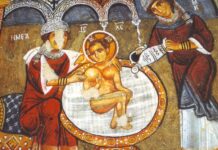Only in recent years has the once ubiquitous midwife fallen to the wayside of hospital births: midwifery is an ancient profession, considered invaluable since antiquity.
“The midwives, however, feared God; they did not do as the king of Egypt had ordered them, but let the boys live.” – Exodus 1:17
Catholic midwives were especially important within the Church’s history, who were tasked with the responsibility of performing an “emergency” baptism if the child to be birthed was in peril.
Often midwives would have to give a “conditional” emergency baptism, using the formulation “in case you are able to receive the baptism…” if the child was in peril of not being born whole or alive.
These baptisms would be recorded later in the baptismal register, and repeated later by a priest to ensure it was done correctly, also using the same “in case you are able” formulation since a child can only be baptized once.
Read below the “instructions for midwives regarding baptisms of young children who were born, or were in peril of not being born whole” printed in Brussels, 1698.
-
- In case there is fear that the child will sicken or die, they shall wash the child with natural water while speaking these words: “I baptize thee in the name of the father, and the son, and the holy spirit, amen.”
- Although it is not necessary to use much water, there shall be enough that the child can be said to have been washed clean.
- If possible, the child shall be baptized on his head, and the water shall touch his body and not just his hair.
- If only some parts of the child have been born already, and there is fear that the child shall die before being fully born, the child will be baptized on those limbs that are already presenting.
- If the midwife is in doubt whether the child still lives, she shall baptize the child with these words: “In case you are able to receive the baptism, I baptize thee in the name of the father, and the son, and the holy spirit, amen.”
- In case only a hand, leg or arm is born, and that it is uncertain whether the child is still alive, the formulation of the conditional baptism shall be used (“In case you are able,” etc), and then as soon as the head or chest is born, the conditional baptism shall be repeated.
- In case that there is risk of death before any limb is born or presenting, and the midwife can reach the child, in those cases she will baptize the child under condition using the words “in case you are able”, etc. And if later any limb does appear, the head or chest shall be washed and baptized using the words “in case you are able,” etc.
Photo credit: Morphart Creation / Shutterstock.com


















St. Claire, cleanse this site of insensitive mischievous abuse.
All holy men and women, martyrs, saints, angels, pray for us.
Holy Family of Nazareth, restore matrimony and family life.
Transform all of mankind’s iniquity into integrity. Amen.
Ecce Crucem Domini!
Fugite partes adversae!
Vicit Leo de tribu Juda,
Radix David! Alleluia!
Saint Anthony of Padua, pray for us. For Italy.
Saint Teresa of Avila, pray for us. For Rome.
Blood of Christ Crucified, cleanse the Vatican.
Amen.